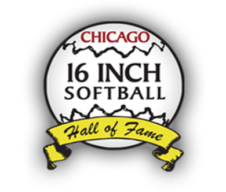When Al Maag first told people about his spit-and-sawdust dream to open a 16-Inch Softball Hall of Fame, they said it would never work.
The passions in this peculiarly Chicago game, they said, ran too deep for opposing players to agree on anything, let alone a museum.
“They said I was crazy,” Maag recalled. “They said all the top players hated each other and wouldn’t sit down together.”
More than 15 years later, Maag’s dream came true Sunday morning, when more than 1,000 players and fans came to Forest Park to celebrate the unveiling of plaques honoring stars of a blue-collar sport as synonymous with the city as ketchup-free hot dogs and deep-dish pizza.
As Survivor songwriter Jim Peterik belted out an acoustic version of his best-known hit, “Eye of the Tiger,” plaques honoring 340 neighborhood heroes of the game were unveiled in Station Park on the 7500 block of Harrison Street, the first stage of what backers hope will ultimately be a 16-Inch Softball Museum.
Stan “Rabbits” Zajac, Don “Ducky” Dulbis, Joe “Geetz” Gucwa, Willie “Steamer” Simpson, Bobby “The Grip” Garippo, Tony “Buzz” Norka, Vito “Tasty” Yario and Nate “Sweetwater” Clifton were among the obscure but evocative names of everyday Joes who worked day jobs as cops, deliverymen and barkeeps, then dazzled the crowds up to 200 nights a year.
“People can’t relate to a baseball player who makes $10 million a year,” Maag said. “But these guys worked hard every day, then rushed to the park to play hard. They did it for the love of the game, not money.”
Invented in Chicago in 1887, 16-inch softball suited the city’s smaller parks and became popular during the Depression because fielders didn’t need to buy a glove.
The game’s history has been preserved at a Hall of Fame Web site since 1996, but organizers hope that a $500,000 state grant pledged Sunday by Illinois Sen. Rickey Hendon (D-Chicago) will ensure that the museum will be completed within a year.
“Gov. Quinn is already aware of it,” Hendon said. “We’re going to find the money somewhere.”
Though unlikely halls of fame honoring the less-than-famous have multiplied across the U.S. — witness the Insurance Hall of Fame in Tuscaloosa, Ala., and the RV Hall of Fame in Elkhart, Ind. — Inductee Park is probably unique in honoring athletes best-known for being unheard of.
Beer-bellied, balding and with knuckles gnarled by decades of barehanded fielding, most players at the unveiling ceremony didn’t look like elite athletes.
As they traded war stories about the late Tribune columnist Mike Royko, who enshrined the game’s tough-guy mythology in his columns and was inducted into the Hall of Fame in 2001, it was easier to imagine them waddling from the dugout to make a Little League pitching change than pounding the base path.
But they quickly dispelled that impression in an all-star game that followed the ceremony, won 17-6 by a team of North Siders that included Bears kicker Robbie Gould over a team of South Siders.
“It’s the old guys that know how to hit,” said Rob Placek, 43, a truck driver and devoted player.
“The truth is, they got those bellies playing softball, because it was a social thing and they’d go to the bar after every game.”
Reflecting on the game’s demise from its mid-century peak, he added that “it’s hard to find two people with the time to do anything together anymore.”
“They were great players,” said Casey Larocco, a quietly dignified 87-year-old Hall of Famer and retired beer truck driver, who won 28 major titles in his 37-year career. Larocco was voted MVP in the 1948 Windy City League title game at White Sox park and he played competitively well into his 50s.
He seemed embarrassed to admit that his sporting activity is now limited to “Ping-Pong twice a week,” but looked as though he could still hit a home run, or unload a keg.
https://www.chicagotribune.com/news/ct-xpm-2009-07-20-0907190260-story.html
